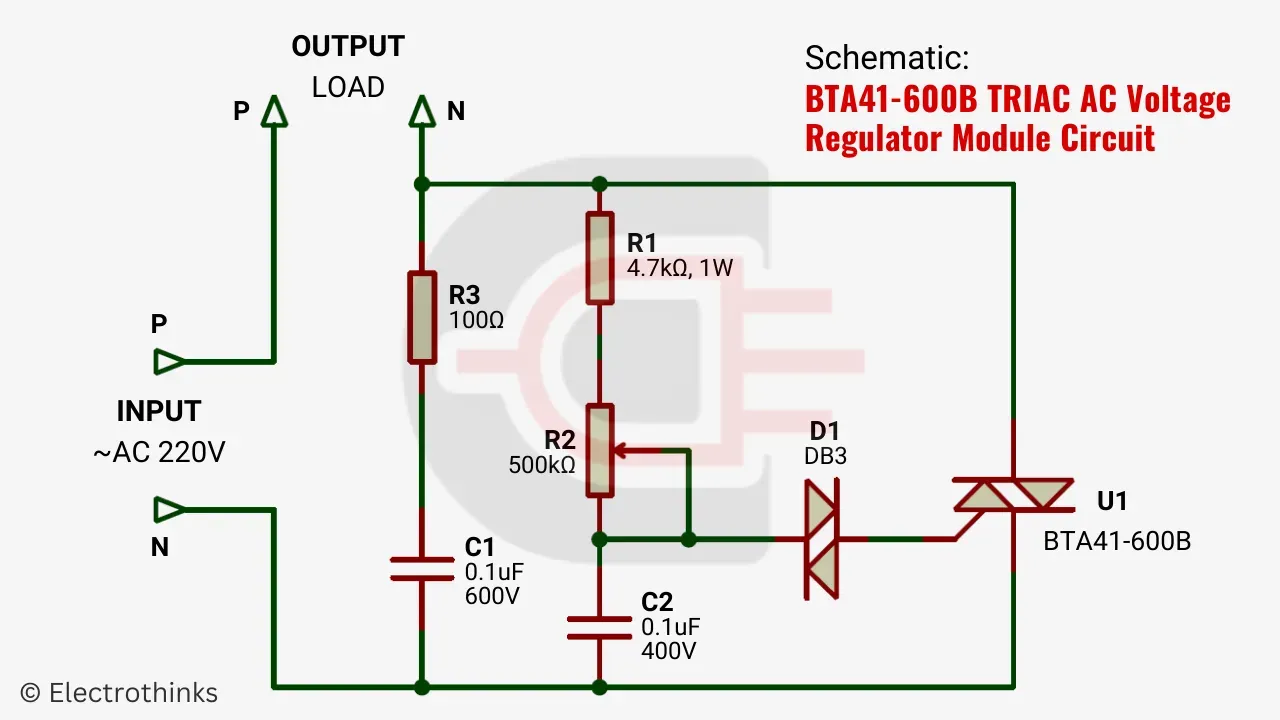BTA41-600B based AC voltage regulator module is a TRIAC controller capable of regulating AC voltage up to 220V and power up to 3000W, making it suitable for dimming lights, controlling motor speeds, and managing temperature.
These module price typically ranged from $1.46 to $3, depending on the supplier and quantity purchased. It's always a good idea to compare prices from different suppliers to find the best deal.
This article will provide detailed information about TRIAC a.c. voltage regulator module, including specifications, circuit diagrams, working principle, applications, and more. Let's get started!
BTA41-600B TRIAC AC Voltage Regulator Module Specifications
The quick specifications of this AC voltage regulator module are given below:
- Type: AC Voltage Regulator
- Model: BTA41-600B
- Input Voltage: AC 220V
- Adjustable Voltage: 0-220V AC
- Maximum Power: 3000W
- AC Frequency: 50-60Hz
- Operating Temperature: -40°C to +150°C
- Dimensions: 57 x 49 x 27 mm
- Weight: 100gm
TRIAC AC Voltage Regulator Circuit Diagram
Schematic of the BTA41-600B triac ac voltage regulator module circuit is shown below.
Components are used in the circuit - U1: BTA41-600B TRIAC, D1: DB3 DIAC, R1: 4.7kΩ Resistor, R2: 500kΩ Potentiometer, C1: 0.1uF 600V Polyester Film Capacitor, R3: 100Ω Resistor, and C2: 0.1uF 400V Polyester Film Capacitor.
Working Principle of TRIAC AC Voltage Regulator
The working principle of the AC Lamp dimmer circuit is based on the use of a TRIAC, which is a bidirectional semiconductor switch that can control the flow of AC current. The BTA41/600B TRIAC is the main component of the AC voltage regulator module and consists of two thyristors connected in parallel but in opposite directions.
The series R3-C1 circuit is designed to limit the rate of voltage rise across the load device during switch off. When the input AC voltage increases positively or negatively, capacitors C1 and C2 charge at a rate determined primarily by resistor R2.
When the voltage across capacitor C2 exceeds the breakover voltage of the diac D1, the diac is triggered into the conducting state, allowing the capacitor C2 to discharge through the conducting diac D1 into the gate of the triac U1. This causes the triac U1 to turn on and pass the AC power to the load, resulting in dimming the light output.
By adjusting the value of the R2 potentiometer, the rate of charge of capacitors and the point at which the triac U1 triggers on the positive or negative half-cycle of the input AC voltage can be controlled. The firing of the triac can be controlled up to a maximum of 180°, allowing continuous control of the load voltage from practically zero to the full RMS value.
TRIAC AC Voltage Regulator Module Applications
The module can be used in power supply circuits to regulate the voltage supplied to the load.
- Light dimming: Control the intensity of light bulbs in residential, commercial, and industrial settings. The module can adjust the power supplied to the light bulb, thereby changing its brightness.
- Motor speed control: It can also be used to control the speed of AC motors. By regulating the voltage supplied to the motor, the module can adjust the motor's speed.
- Temperature control: Regulate the power supplied to heating elements, such as those used in ovens and heaters. By adjusting the power supplied to the heating element, the module can regulate the temperature of the device.








No comments
If you have any doubts or questions, please let me know. Don't add links as it goes to spam. Share your valuable feedback. Thanks